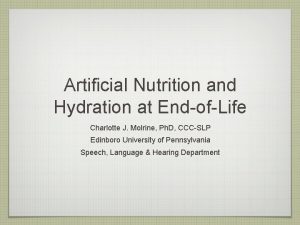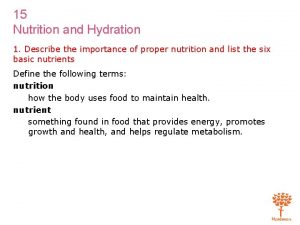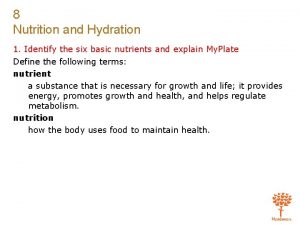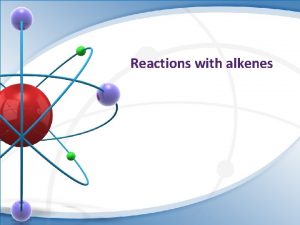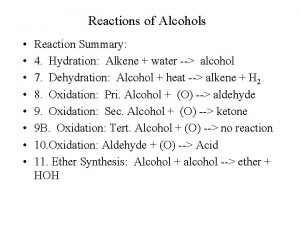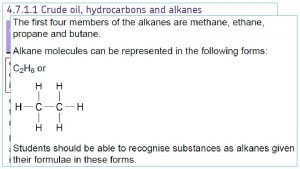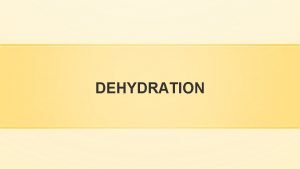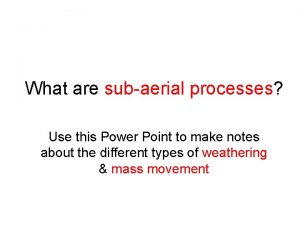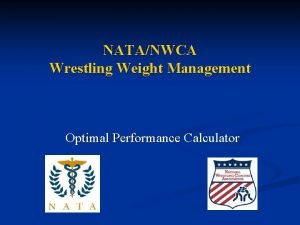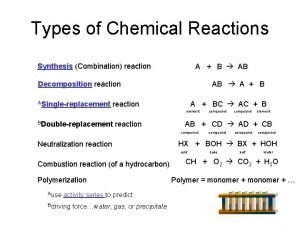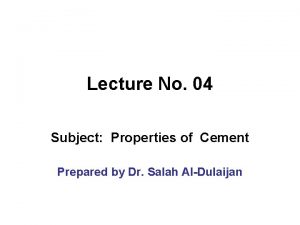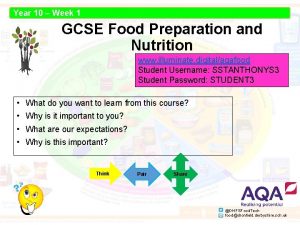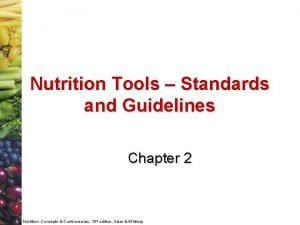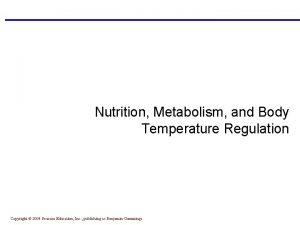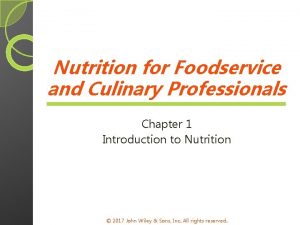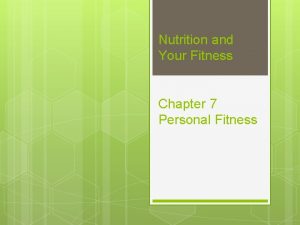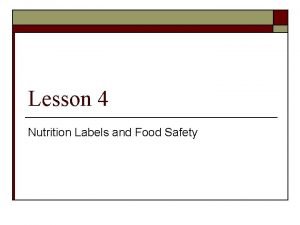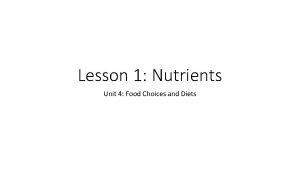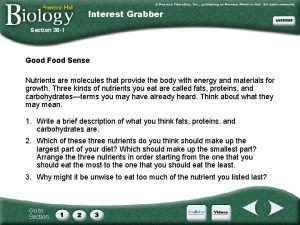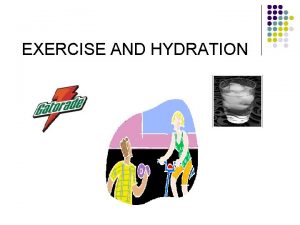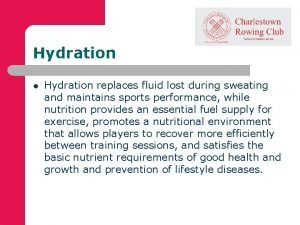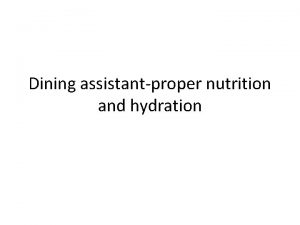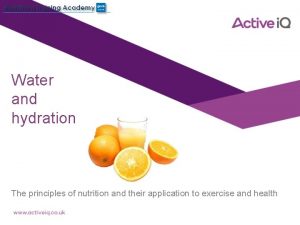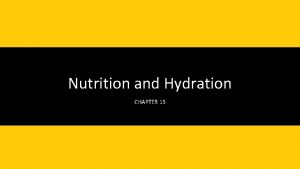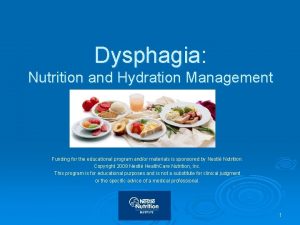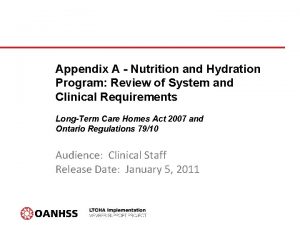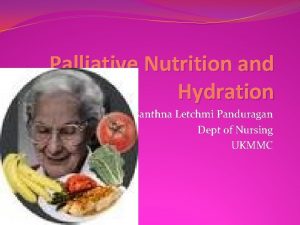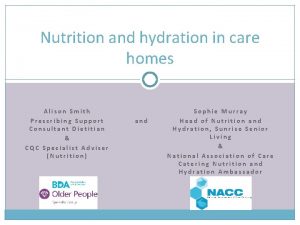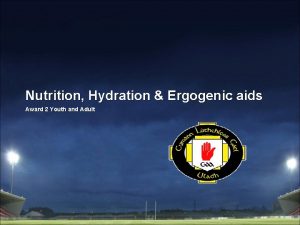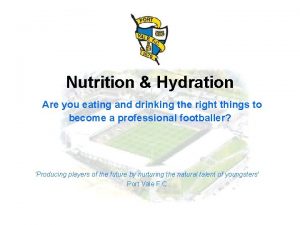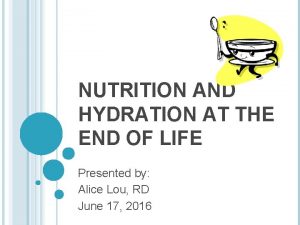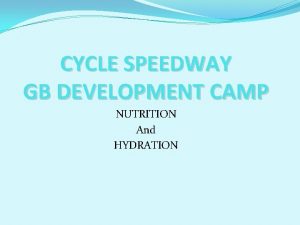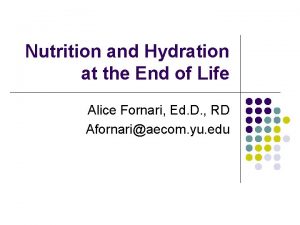8 Nutrition and Hydration 1 Identify the six










































































- Slides: 74

8 Nutrition and Hydration 1. Identify the six basic nutrients and explain My. Plate Define the following terms: nutrient a substance that is necessary for growth and life; it provides energy, promotes growth and health, and helps regulate metabolism. nutrition how the body uses food to maintain health.

8 Nutrition and Hydration 1. Identify the six basic nutrients and explain My. Plate REMEMBER: A well-balanced diet will help residents maintain muscles and skin tissues and prevent pressure ulcers.

8 Nutrition and Hydration Transparency 8 -1: Six Basic Nutrients • • • Water Carbohydrates Protein Fats Vitamins Minerals

8 Nutrition and Hydration 1. Identify the six basic nutrients and explain My. Plate Important facts about water: • Most essential nutrient for life • We need about 64 ounces per day. • Water aids in • Digestion • Absorption of food • Elimination of wastes • Maintaining normal body temperature

8 Nutrition and Hydration 1. Identify the six basic nutrients and explain My. Plate Important facts about carbohydrates: • Provide energy and extra protein • Provide fiber • Complex carbohydrates include bread, cereal, potatoes, rice, pasta, vegetables, and fruits • Simple carbohydrates include sugars, sweets, syrups, and jellies

8 Nutrition and Hydration 1. Identify the six basic nutrients and explain My. Plate Important facts about protein: • Essential for tissue growth and repair • Provides a supply of energy • Protein includes seafood, poultry, meat, eggs, milk, cheese, nuts, nut butters, peas, dried beans or legumes, and soy products

8 Nutrition and Hydration 1. Identify the six basic nutrients and explain My. Plate Important facts about fats: • Help the body store energy • Add flavor to food • Include butter, margarine, salad dressings, oils, and animal fats found in meat, dairy products, fowl, and fish • Monounsaturated and polyunsaturated vegetable fats are healthier fats.

8 Nutrition and Hydration 1. Identify the six basic nutrients and explain My. Plate Important facts about vitamins: • Vitamins are essential to body functions. • Fat-soluble vitamins are A, D, E, and K. • Water-soluble vitamins are B and C.

8 Nutrition and Hydration 1. Identify the six basic nutrients and explain My. Plate Important facts about minerals: • Minerals form and maintain body functions. • Include zinc, iron, sodium, potassium, calcium, magnesium, and phosphorus

8 Nutrition and Hydration Handout 8 -1: Vitamins and Minerals VITAMIN SOURCE FUNCTION Vitamin A dark green and yellow vegetables, such as broccoli and turnips assists with skin and eye development; keeps the skin healthy; helps the eyes adjust to dim light; helps the linings of the respiratory and digestive tracts resist infection Vitamin C fruits such as oranges, strawberries, grapefruit, and cantaloupe; vegetables such as broccoli, cabbage, brussels sprouts, and green peppers assists with healing wounds and building bones and teeth; holds cells together; strengthens the walls of blood vessels; and helps the body absorb iron Vitamin B 2 or riboflavin milk, milk products, lean meat, green leafy vegetables, eggs, breads, and cereals helps cells use oxygen, which allows them to release energy from food; important for protein and carbohydrate metabolism; needed for growth, healthy eyes, skin, and mucous membranes

8 Nutrition and Hydration Handout 8 -1: Vitamins and Minerals (cont’d) VITAMIN SOURCE FUNCTION Vitamin B 3 or niacin lean meat, poultry, fish, peanuts and peanut butter, whole grain breads and cereals, peas, beans, and eggs important for protein, carbohydrate, and fat metabolism; important for appetite; important for the functioning of the skin, tongue, nervous system, and digestive system; helps cells use oxygen for energy Vitamin D milk, butter, liver, and fish liver oils; also obtained by exposing the body to direct sunlight, which interacts with the cholesterol in the skin responsible for the body’s absorption of the minerals calcium and phosphorus and contributes to the formation of healthy bones; especially important to growing children and women who are pregnant or breastfeeding Vitamin E cereals, nuts, vegetable oils, wheat germ, vegetables, fish, and fruits antioxidant that protects the body from damage from free radicals; helps boost the immune system; assists in formation of red blood cells Thiamin lean pork, dried beans, peas, whole grain and enriched breads and cereals, and certain types of nuts helps the body obtain energy from foods

8 Nutrition and Hydration Handout 8 -1: Vitamins and Minerals (cont’d) Mineral SOURCE FUNCTION Iron egg yolks, green leafy vegetables, breads, cereals, and organ meats necessary for red blood cells to carry oxygen; helps in the formation of enzymes Sodium almost all foods and table salt important for maintaining fluid balance (helps the body retain water) Calcium milk and milk products, such as cheese, ice cream, and yogurt; green leafy vegetables, such as collards, kale, mustard, dandelion, and turnip greens; and canned fish with soft bones, such as salmon important for the formation of teeth and bones, the clotting of blood, muscle contraction, and heart and nerve function Potassium fruits and vegetables, cereals, coffee, and meats essential for nerve and heart function and muscle contraction Phosphorus milk, milk products, meat, fish, poultry, nuts, and eggs needed for the formation of bones and teeth and for nerve and heart function; important for the body’s utilization of proteins, fats, and carbohydrates

8 Nutrition and Hydration Transparency 8 -2: My. Plate

8 Nutrition and Hydration 1. Identify the six basic nutrients and explain My. Plate NAs should remember these points about vegetables and fruits: • Half a person’s plate should consist of fruits and vegetables. • Dark green, red, and orange vegetables have the best nutritional content. • Vegetables are low in fat and calories and have no cholesterol. • Vegetables provide fiber and vitamins. • Fruits are low in fat, sodium, and calories and have no cholesterol. • Fruits provide vitamins and fiber.

8 Nutrition and Hydration 1. Identify the six basic nutrients and explain My. Plate NAs should remember these points about grains: • At least half of all grains consumed should be whole grains. • Whole grains contain the bran and germ, as well as the endosperm. Refined grains retain only the endosperm. • Grains are found in cereal, bread, rice, and pasta.

8 Nutrition and Hydration 1. Identify the six basic nutrients and explain My. Plate NAs should remember these points about proteins: • Meat, poultry, seafood, and eggs are animal sources of proteins. Beans, peas, soy products, nuts, and seeds are plant sources of proteins. • Eat seafood twice a week in place of meat or poultry. • Choose lean meat and poultry. Include eggs and egg whites on a regular basis. • Eat plant-based protein foods often. • Some nuts and seeds (flax, walnuts) are excellent sources of essential fatty acids.

8 Nutrition and Hydration 1. Identify the six basic nutrients and explain My. Plate NAs should remember these points about dairy: • Provides protein, vitamins, and minerals • Includes all of the foods made from milk that retain their calcium content, such as yogurt and cheese • Most dairy group choices should be fat-free or low-fat (1%). • Choose fat-free or low-fat milk or yogurt more often than cheese. • Soy products enriched with calcium are an alternative to dairy foods.

8 Nutrition and Hydration 1. Identify the six basic nutrients and explain My. Plate NAs should remember these tips for making healthy food choices: • Balance calories. • Enjoy your food, but eat less. • Avoid oversized portions. • Eat these foods more often: vegetables, fruits, whole grains, and fat-free or 1% milk and low-fat dairy products. • Eat these foods less often: foods high in solid fats, added sugars, and salt. These foods include fatty meats, like bacon and hot dogs, cheese, fried foods, ice cream, and cookies. • Compare sodium in foods. Select canned foods that are labeled sodium-free, very low sodium, low-sodium, or reduced sodium. • Drink water instead of sugary drinks.

8 Nutrition and Hydration 2. Describe factors that influence food preferences REMEMBER: It is very important to know and follow residents’ food preferences. NAs should ask questions about preferences and pay attention to residents’ responses.

8 Nutrition and Hydration 2. Describe factors that influence food preferences Think about this question: Do you have any regional, cultural, or religion-based food preferences?

8 Nutrition and Hydration 2. Describe factors that influence food preferences REMEMBER: Residents have a legal right to make choices about their food and to refuse food. NAs must honor residents’ beliefs and preferences.

8 Nutrition and Hydration 3. Explain special diets Define the following terms: special, modified, or therapeutic diets for people who have certain illnesses. puree to blend or grind food into a thick paste of baby food consistency.

8 Nutrition and Hydration 3. Explain special diets The following are all types of special diets NAs may encounter in LTC facilities: • Low-sodium diet • Fluid-restricted diet • Low-protein diet • Low-fat/low-cholesterol diet • Modified calorie diet • Diabetic diet • Vegetarian diet • Liquid diet • Soft and mechanical soft diet • Pureed diet

8 Nutrition and Hydration 3. Explain special diets Think about this question: Are you already familiar with any of these special diets?

8 Nutrition and Hydration 3. Explain special diets Residents may be advised to add a high-nutrition supplement to a regular or modified diet. NAs should know these facts about supplements: • Usually added to diet to encourage weight gain or intake of proteins, vitamins, or minerals • May come in powdered or liquid form • NAs should follow facility policy about mixing supplements; they may not be allowed to do so • NAs can help by patiently encouraging residents to drink their supplements • A resident has the right to refuse a supplement; refusal should be reported to the nurse

8 Nutrition and Hydration 4. Describe how to assist residents in maintaining fluid balance Define the following terms: force fluids (FF) a medical order to encourage a person to drink more fluids. restrict fluids (RF) a medical order to limit the amount of fluids a person drinks to the level set by the doctor. NPO (nothing by mouth) medical order to withhold all food and fluids taken orally. dehydration a serious condition that results from inadequate fluid in the body.

8 Nutrition and Hydration 4. Describe how to assist residents in maintaining fluid balance Fluid intake is important because it • Helps prevent constipation and incontinence • Dilutes wastes and flushes out urinary system • May help prevent confusion

8 Nutrition and Hydration 4. Describe how to assist residents in maintaining fluid balance REMEMBER: A resident with an order for NPO (nothing by mouth) cannot have any food or drink. An NA should never offer food or drink - not even water - to a resident who is designated NPO.

8 Nutrition and Hydration 4. Describe how to assist residents in maintaining fluid balance The following guidelines can help prevent dehydration: • Report warning signs immediately. • Encourage residents to drink every time you see them. • Offer fresh water and fluids often. • Offer other forms of liquids if permitted (e. g. , ice chips, frozen flavored ice sticks, gelatin). • Offer sips of liquids between bites of food. • Make sure pitcher and cup are close by and are light enough for resident to lift. • Offer assistance. • Record fluid I&O.

8 Nutrition and Hydration 4. Describe how to assist residents in maintaining fluid balance Signs and symptoms of dehydration include • Drinking less than six 8 -ounce glasses of liquid per day • Drinking little or no fluids at meals • Needing help drinking from cup • Having trouble swallowing liquids • Having frequent vomiting, diarrhea, or fever

8 Nutrition and Hydration 4. Describe how to assist residents in maintaining fluid balance Signs and symptoms of dehydration (cont’d): • Being easily confused or tired • Resident has any of the following: • Dry mouth • Cracked lips • Sunken eyes • Dark urine • Strong-smelling urine • Weight loss • Complaints of abdominal pain

8 Nutrition and Hydration 4. Describe how to assist residents in maintaining fluid balance REMEMBER: If an NA approaches residents positively, with a question like “Would you like water or juice? ” rather than “Do you want anything to drink? ” the resident is more likely to stay well hydrated.

8 Nutrition and Hydration 4. Describe how to assist residents in maintaining fluid balance REMEMBER: NAs should make an effort to find out what residents’ favorite beverages are and offer these at least three times a day, in addition to the beverages served at meals.

Serving fresh water Equipment: water pitcher, ice scoop, glass, straw, gloves 1. Identify yourself by name. Identify the resident by name. Resident has right to know identity of his or her caregiver. Addressing resident by name shows respect and establishes correct identification. 2. Wash your hands. Provides for infection prevention. 3. Put on gloves. Promotes infection prevention. 4. Scoop ice into water pitcher. Add fresh water. 5. Use and store ice scoop properly. Do not allow ice to touch your hand fall back into container. Place scoop in proper receptacle after each use. Avoids contamination of ice. 6. Take pitcher to resident.

Serving fresh water 7. Pour glass of water for resident. Leave pitcher and glass at the bedside. Encourages resident to maintain hydration. 8. Make sure that pitcher and glass are light enough for resident to lift. Leave a straw if the resident desires it and does not have swallowing problems. Demonstrates understanding of resident’s abilities and/or limitations. Prevents dehydration. 9. Place call light within resident’s reach. Allows resident to communicate with staff as necessary. 10. Remove and discard gloves. 11. Wash your hands. Provides for infection prevention.

8 Nutrition and Hydration 4. Describe how to assist residents in maintaining fluid balance Define the following terms: fluid overload a condition that occurs when the body cannot handle the amount of fluid consumed. edema swelling caused by excess fluid in body tissues.

8 Nutrition and Hydration 4. Describe how to assist residents in maintaining fluid balance Signs and symptoms of fluid overload include • Swelling of extremities • Weight gain • Decreased urine • Shortness of breath • Increased heart rate • Anxiety • Tight, smooth, or shiny skin

8 Nutrition and Hydration 5. List ways to identify and prevent unintended weight loss REMEMBER: Unintended weight loss is a serious problem for the elderly. It can lead to skin breakdown and/or malnutrition.

8 Nutrition and Hydration 5. List ways to identify and prevent unintended weight loss NAs should remember these guidelines for preventing unintended weight loss: • Report observations and warning signs to the nurse. • Food should look, taste, and smell good. • Encourage residents to eat; talk positively about food. • Honor food likes/dislikes. • Offer different kinds of foods and beverages. • Help residents who have trouble self-feeding.

8 Nutrition and Hydration 5. List ways to identify and prevent unintended weight loss Guidelines for preventing unintended weight loss (cont’d): • Season foods to residents’ preferences. • Allow plenty of time to finish eating. • Tell nurse if residents have trouble with utensils. • Record meal/snack intake. • Give oral care before and after meals. • Position residents upright for feeding. • If resident has low appetite or seems sad, ask about it.

8 Nutrition and Hydration 5. List ways to identify and prevent unintended weight loss NAs should observe for and report the following regarding a resident’s appetite: • Resident needs help eating/drinking • Resident eats less than 70% of food • Resident has mouth pain • Resident’s dentures do not fit • Resident has difficulty chewing or swallowing • Resident coughs or chokes while eating • Resident is sad, has crying spells, or withdraws • Resident is confused, wanders, or paces

8 Nutrition and Hydration 6. Identify ways to promote appetites at mealtime REMEMBER: Meals are not only a time for getting nourishment but a time for socialization as well. Making mealtime pleasant for residents is one of the most important things an NA can do to help residents get proper nutrition.

8 Nutrition and Hydration 6. Identify ways to promote appetites at mealtime NAs should remember these guidelines for promoting appetites: • Assist with grooming/hygiene tasks before dining as needed. • Give oral care before eating if requested. • Offer a trip to the bathroom or help with toileting before eating. • Assist with handwashing. • Encourage use of dentures, eyeglasses, and hearing aids. • Check the environment. Address odors. Keep noise level low. Do not shout or bang plates or cups.

8 Nutrition and Hydration 6. Identify ways to promote appetites at mealtime Guidelines for promoting appetites (cont’d): • Seat residents next to friends. • Properly position residents for eating, which is normally in the upright position. • Serve food promptly to maintain correct temperature. • Plates should look appetizing. • Give proper eating tools, including assistive utensils if needed. • Be cheerful, positive, and helpful. • Give additional food when requested.

8 Nutrition and Hydration 7. Demonstrate how to assist with eating When assisting residents with eating NAs should remember the following: • Residents will need different levels of help. • Some residents will only need help with setting up but can feed themselves. • Some residents will need to be fed. Be sensitive and give privacy. • Encourage residents to do what they can.

8 Nutrition and Hydration 7. Demonstrate how to assist with eating Guidelines for assisting a resident with eating are as follows: • Wash your hands. • Identify residents before serving meals. • Sit at resident’s eye level. • Allow time for prayer if the resident wishes. • Be supportive and encouraging. Do not treat the resident like a child. • Do not touch food to test its temperature. Use a hand over the dish instead. • Cut foods and pour liquids as needed.

8 Nutrition and Hydration 7. Demonstrate how to assist with eating Guidelines for assisting a resident with eating (cont’d): • Identify foods and fluids that are in front of resident. Call pureed food by the correct name. • Ask resident what he wants to eat first. Allow resident to make the choice. • Do not mix foods unless resident prefers it. • Do not rush the meal. • Be social and friendly. Converse if the residentwishes to do so. • Give resident full attention. • Alternate food and drink, cold and hot, and bland sweets. • Honor requests for different food.

8 Nutrition and Hydration 7. Demonstrate how to assist with eating REMEMBER: An NA should not insist that a resident use a clothing protector, and should never refer to a clothing protector as a bib.

Feeding a resident Equipment: meal, eating utensils, clothing protector, washcloths or wipes 1. Identify yourself by name. Identify the resident by name. Resident has right to know identity of his or her caregiver. Addressing resident by name shows respect and establishes correct identification. 2. Wash your hands. Provides for infection prevention. 3. Explain procedure to resident. Speak clearly, slowly, and directly. Maintain face-to-face contact whenever possible. Promotes understanding and independence. 4. Look at the diet card or menu. Ask resident to state her name. Verify that resident has received the right tray. Tray should only contain foods, fluids, and condiments permitted on the diet.

Feeding a resident 5. Raise the head of the bed. Make sure resident is in an upright sitting position (at a 90 -degree angle). Promotes ease of swallowing. Prevents aspiration of food and beverage. 6. Adjust bed height to where you will be able to sit at resident’s eye level. Lock bed wheels. 7. Place meal tray where it can be easily seen by the resident, such as on the overbed table. 8. Help resident to clean her hands with hand wipes if resident cannot do it herself. Promotes good hygiene and infection prevention. 9. Help resident to put on clothing protector if desired. Protects resident’s clothing from food and beverage spills.

Feeding a resident 10. Sit facing resident at the resident’s eye level. Sit on the stronger side if the resident has onesided weakness. Promotes good communication. Lets resident know that he or she will not be rushed while eating. 11. Tell the resident what foods are on the plate. Ask resident what she would like to eat first. Resident has legal right to make decisions.

Feeding a resident 1. Check the temperature of the food. Using utensils, offer the food in bite-sized pieces. Tell the resident the content of each bite of food offered. Alternate types of food, allowing for resident’s preferences. Do not feed all of one type before offering another type. (cont’d. )

Feeding a resident Make sure resident’s mouth is empty before next bite or sip. Report any swallowing problems to the nurse immediately. Small pieces are easier to chew and lessen the risk of choking. If the mouth is empty before offering more food, it lessens the risk of choking. 13. Offer sips of beverage to the resident throughout the meal. If you are holding the cup, touch it to the resident’s lips before you tip it. Give small, frequent sips. Promotes ease of swallowing.

Feeding a resident 14. Talk with the resident during the meal. Do not rush the resident. Makes mealtime more enjoyable. 15. Use washcloth or wipes to wipe food from resident’s mouth and hands as needed during the meal. Wipe mouth and hands at the end of the meal. Maintains resident’s dignity. 16. Remove clothing protector if used. Dispose of it in proper container.

Feeding a resident 17. Remove the food tray. Check for eyeglasses, dentures, or any personal items before removing tray. Place tray in proper area. 18. Make resident comfortable. Keep resident in the upright position for at least 30 minutes if ordered. Make sure bed is free from crumbs. Food left on sheets can cause skin breakdown. 19. Return bed to lowest position. Remove privacy measures. Provides for safety. 20. Place call light within resident’s reach. Allows resident to communicate with staff as necessary. 21. Wash your hands. Provides for infection prevention.

Feeding a resident 22. Report any changes in resident to the nurse. Provides nurse with information to assess resident. 23. Document procedure using facility guidelines. If you do not document the care, legally it did not happen.

8 Nutrition and Hydration 7. Demonstrate how to assist with eating REMEMBER: NAs may be asked to track the amount of food a resident is eating. Methods of measuring food intake differ from facility to facility. NAs should know which method to use and how to use it.

8 Nutrition and Hydration 8. Identify signs and symptoms of swallowing problems Define the following term: dysphagia difficulty swallowing.

8 Nutrition and Hydration 8. Identify signs and symptoms of swallowing problems Any of the following can cause dysphagia: • Stroke • Head/neck cancer • Multiple sclerosis • Parkinson’s disease • Alzheimer’s disease

8 Nutrition and Hydration 8. Identify signs and symptoms of swallowing problems The following are signs and symptoms of swallowing problems and must be reported to the nurse: • Coughing during or after meals • Choking during meals • Dribbling saliva, food, or fluid from the mouth • Having food residue inside the mouth or cheeks during and after meals • Gurgling during or after meals or losing voice • Eating slowly • Avoiding eating

8 Nutrition and Hydration 8. Identify signs and symptoms of swallowing problems Signs and symptoms of swallowing problems (cont’d): • Spitting out pieces of food • Swallowing several times per mouthful • Clearing the throat frequently during and after meals • Watering eyes when eating or drinking • Food or fluid coming up into the nose • Making a visible effort to swallow • Breathing rapidly while eating or drinking • Difficulty chewing food • Difficulty swallowing medications

8 Nutrition and Hydration 8. Identify signs and symptoms of swallowing problems NAs should know these facts about thickened liquids: • Thickening improves the ability to control fluid in the mouth and throat. • A doctor orders the necessary thickness after evaluation by a speech-language pathologist. • Some beverages arrive already thickened. • NAs cannot offer residents who must have thickened liquids regular liquids, including water.

8 Nutrition and Hydration 8. Identify signs and symptoms of swallowing problems The three thickened consistencies are • Nectar thick - the thickness of pear nectar or tomato juice • Honey thick - the thickness of honey; usually consumed with a spoon • Pudding thick - the thickness of pudding; must be consumed with a spoon

8 Nutrition and Hydration Transparency 8 -3: Preventing Aspiration • • • Position in a straight, upright position for eating or drinking. Offer small pieces of food or small spoonfuls of pureed food. Feed resident slowly. Place food in the unaffected/stronger side of the mouth. Make sure mouth is empty before offering next bite of food or sip of drink. • Keep residents in the upright position for at least 30 minutes after eating and drinking.

8 Nutrition and Hydration 8. Identify signs and symptoms of swallowing problems NAs should remember these guidelines for preventing aspiration: • Position in a straight, upright position for eating and drinking. • Offer small pieces of food or small spoonfuls of pureed food. • Feed resident slowly. • Place food in the unaffected side of the mouth. • Make sure mouth is empty before offering next bite of food or sip of drink. • Have residents remain upright for at least 30 minutes after eating and drinking.

8 Nutrition and Hydration 8. Identify signs and symptoms of swallowing problems Define the following terms: total parenteral nutrition (TPN) the intravenous infusion of nutrients administered directly into the bloodstream, bypassing the digestive system. nasogastric tube a feeding tube that is inserted into the nose and goes to the stomach. percutaneous endoscopic gastrostomy (PEG) tube a feeding tube placed through the abdominal wall into the stomach. gastrostomy a surgically-created opening into the stomach that allows insertion of a tube.

8 Nutrition and Hydration 8. Identify signs and symptoms of swallowing problems REMEMBER: An NA’s role in tube feedings is observation for problems and changes in the resident. NAs never insert or remove tubes, do the feeding, or clean the tubes.

8 Nutrition and Hydration 8. Identify signs and symptoms of swallowing problems Guidelines for tube feedings are as follows: • Wash hands before assisting with tube feedings. • Make sure tubing is not coiled or kinked. • Be aware of NPO orders. • Report if tube comes out. • Doctor prescribes feedings. They will be in liquid form and served at room temperature. • Head of the bed should always remain elevated at 30 degrees, but during feedings the head of the bed should be elevated at least 45 degrees. Resident should stay upright after eating as long as ordered (at least 30 minutes). • Give careful skin care.

8 Nutrition and Hydration 8. Identify signs and symptoms of swallowing problems NAs should observe for and report the following regarding tube feedings: • Redness/drainage around opening • Skin sores or bruises • Cyanotic skin • Resident complaints of pain or nausea • Choking or coughing • Vomiting

8 Nutrition and Hydration 8. Identify signs and symptoms of swallowing problems Observe and report, tube feedings (cont’d): • Diarrhea • Swollen abdomen • Fever • Tube falls out • Problems with equipment • Sound of feeding pump alarm • Change of resident’s inclined position

8 Nutrition and Hydration 9. Describe how to assist residents with special needs REMEMBER: Residents with certain conditions or diseases, such as stroke, Parkinson’s disease, Alzheimer’s disease or other dementias, head trauma, blindness or confusion may need special assistance when eating.

8 Nutrition and Hydration 9. Describe how to assist residents with special needs NAs should remember these helpful dining techniques for assisting residents with special needs: • Use assistive devices as ordered. • Use physical cues like placing your hand over his. • Use short, clear verbal cues (e. g. , “Pick up your spoon” and “Put some carrots on your spoon”). Wait until one task is finished before giving the next cue. • For visually impaired residents, use imaginary clock face to explain position of food on plate.

8 Nutrition and Hydration 9. Describe how to assist residents with special needs Helpful dining techniques for assisting residents with special needs (cont’d): • For residents who have had CVA, place food in unaffected or stronger side of mouth. Make sure food is swallowed. • If resident has blind spots, place food in field of vision. • If resident has tremors, use physical cues and place food and drinks close to resident. • Place residents with poor balance in dining room chair with armrests. If resident leans, ask her to keep elbows on the table.

8 Nutrition and Hydration 9. Describe how to assist residents with special needs Helpful dining techniques for assisting residents with special needs (cont’d): • If resident has poor neck control, neck brace may be used to stabilize head. If resident is in a geri-chair, a wedge cushion behind the head and shoulders may be used. • If resident bites utensils, ask him to open his mouth. Wait until jaw relaxes to remove utensil. • If resident pockets food in cheeks, remind him to chew and swallow. Touch cheek. Ask him to use his tongue to get the food. • If resident holds food in mouth, ask her to chew and swallow. Gently press down on tongue when removing spoon from the mouth to help trigger swallowing. Make sure resident has swallowed before offering more food.
 Pros and cons of artificial nutrition and hydration
Pros and cons of artificial nutrition and hydration Nutrition and hydration chapter 15
Nutrition and hydration chapter 15 Chapter 8 nutrition and hydration
Chapter 8 nutrition and hydration Cyanohydrin formation
Cyanohydrin formation Hydration vs hydrogenation
Hydration vs hydrogenation Alkene reactions summary
Alkene reactions summary Ethanol covalent
Ethanol covalent Hydration level chart
Hydration level chart Is acid catalyzed hydration syn or anti
Is acid catalyzed hydration syn or anti Addition of icl on propene gives the product
Addition of icl on propene gives the product Addition of hydrogen halides to alkynes
Addition of hydrogen halides to alkynes Mercury catalyzed hydration of alkynes
Mercury catalyzed hydration of alkynes Mercury catalyzed hydration of alkynes
Mercury catalyzed hydration of alkynes Is acid catalyzed hydration syn or anti
Is acid catalyzed hydration syn or anti Sub-aerial processes
Sub-aerial processes Hydrolysis in geography
Hydrolysis in geography Opc wrestling
Opc wrestling Polar molecule
Polar molecule Hydration shells
Hydration shells Give an example of combination reaction
Give an example of combination reaction Lattice enthalpy definition ocr
Lattice enthalpy definition ocr Heat of hydration
Heat of hydration Classify each polygon
Classify each polygon Identify the six positioning steps
Identify the six positioning steps Hình ảnh bộ gõ cơ thể búng tay
Hình ảnh bộ gõ cơ thể búng tay Slidetodoc
Slidetodoc Bổ thể
Bổ thể Tỉ lệ cơ thể trẻ em
Tỉ lệ cơ thể trẻ em Chó sói
Chó sói Glasgow thang điểm
Glasgow thang điểm Chúa yêu trần thế
Chúa yêu trần thế Môn thể thao bắt đầu bằng chữ f
Môn thể thao bắt đầu bằng chữ f Thế nào là hệ số cao nhất
Thế nào là hệ số cao nhất Các châu lục và đại dương trên thế giới
Các châu lục và đại dương trên thế giới Công thức tính độ biến thiên đông lượng
Công thức tính độ biến thiên đông lượng Trời xanh đây là của chúng ta thể thơ
Trời xanh đây là của chúng ta thể thơ Mật thư tọa độ 5x5
Mật thư tọa độ 5x5 Làm thế nào để 102-1=99
Làm thế nào để 102-1=99 Phản ứng thế ankan
Phản ứng thế ankan Các châu lục và đại dương trên thế giới
Các châu lục và đại dương trên thế giới Thơ thất ngôn tứ tuyệt đường luật
Thơ thất ngôn tứ tuyệt đường luật Quá trình desamine hóa có thể tạo ra
Quá trình desamine hóa có thể tạo ra Một số thể thơ truyền thống
Một số thể thơ truyền thống Cái miệng nó xinh thế
Cái miệng nó xinh thế Vẽ hình chiếu vuông góc của vật thể sau
Vẽ hình chiếu vuông góc của vật thể sau Nguyên nhân của sự mỏi cơ sinh 8
Nguyên nhân của sự mỏi cơ sinh 8 đặc điểm cơ thể của người tối cổ
đặc điểm cơ thể của người tối cổ Ví dụ giọng cùng tên
Ví dụ giọng cùng tên Vẽ hình chiếu đứng bằng cạnh của vật thể
Vẽ hình chiếu đứng bằng cạnh của vật thể Phối cảnh
Phối cảnh Thẻ vin
Thẻ vin đại từ thay thế
đại từ thay thế điện thế nghỉ
điện thế nghỉ Tư thế ngồi viết
Tư thế ngồi viết Diễn thế sinh thái là
Diễn thế sinh thái là Dạng đột biến một nhiễm là
Dạng đột biến một nhiễm là Số nguyên tố là số gì
Số nguyên tố là số gì Tư thế ngồi viết
Tư thế ngồi viết Lời thề hippocrates
Lời thề hippocrates Thiếu nhi thế giới liên hoan
Thiếu nhi thế giới liên hoan ưu thế lai là gì
ưu thế lai là gì Sự nuôi và dạy con của hươu
Sự nuôi và dạy con của hươu Khi nào hổ mẹ dạy hổ con săn mồi
Khi nào hổ mẹ dạy hổ con săn mồi Sơ đồ cơ thể người
Sơ đồ cơ thể người Từ ngữ thể hiện lòng nhân hậu
Từ ngữ thể hiện lòng nhân hậu Thế nào là mạng điện lắp đặt kiểu nổi
Thế nào là mạng điện lắp đặt kiểu nổi Gcse food tech high skill dishes
Gcse food tech high skill dishes Food
Food Temperature regulation
Temperature regulation Nutrition for foodservice and culinary professionals
Nutrition for foodservice and culinary professionals Chapter 7 nutrition and your fitness
Chapter 7 nutrition and your fitness Datingoo
Datingoo Food and nutrition unit 4
Food and nutrition unit 4 38-2 the process of digestion
38-2 the process of digestion Food and nutrition unit 5
Food and nutrition unit 5
